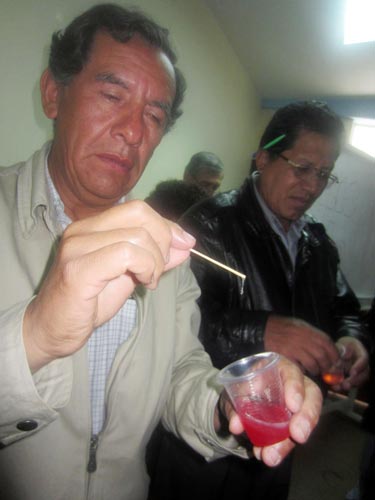By Luis Narro/CIMMYT
The computer programming language “R” can help crop researchers with data analysis and interpretation, students learned during a course on the tool this month. Held at the National University of Cajamarca in Peru from 11 to 15 November, the course promoted the use of “R” in crop improvement.
Data analysis is crucial for comparing the performance of maize hybrids and evaluating experiments. Free of charge and useful for analyzing diverse types of data, the “R” program has been around for about a decade but is relatively new and unknown in South America. It was developed by two statisticians in New Zealand. CIMMYT and the university’s College of Engineers organized the event, which drew some 70 participants from experiment stations from Peru’s National Institute for Technological Innovation (INIA), universities and governmental organizations with research programs. Teachers included Ramón Giraldo Henao from the National University of Colombia, Felipe de Mendiburu from the La Molina National Agrarian University in Lima, Carlos Urrea Florez from Nebraska State University and Luis Narro León from CIMMYT.

Mendiburu, who developed the application Agricolae for R, taught the participants how to use the program. The application is specifically designed for the planning and analysis of agricultural and plant breeding experiments. Giraldo presented on the various uses of “R,” including its applications in statistics, types of variables and measurement scales, measures of location and shape variability, probability, sampling distributions, hypothesis testing, regression, analysis of variance and contingency tables. Urrea described bean breeding with emphasis on the use of molecular markers to improve disease tolerance. Participants then used salt, detergent and alcohol to extract DNA from strawberries.
Luis Narro León explained maize breeding programs using conventional and unconventional methods. “The strategy of maize breeding program should be aimed at the production of hybrids as the ultimate goal,” Narro said. Carlos Tirado Soto from the National University of Cajamarca opened and closed the course, thanking CIMMYT and its collaborators offering the continued financial and logistical support of the university for similar events in the future. CIMMYT thanks Luis Alcantara, Héctor Cabrera, Alicia Medina, Miguel Angel Pots, Jorge Piedra and Víctor Sánche, from the College of Engineers, for their logistical support. Representing course participants, Vladimir Jara thanked the organizers for the opportunity and said he hoped that training would continue for researchers and teachers in Peru.
 Capacity development
Capacity development 
